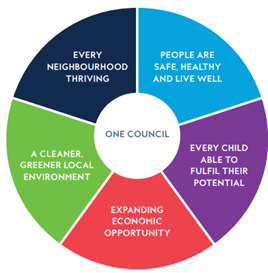Rotherham Metropolitan Borough Council (the Council) is pleased to present the Rotherham Market Position Statement (MPS) which has been produced to:
- Provide an overview of the demographic profile,
- Define our current market and the current and projected demand,
- Describe our strategic priorities,
- Indicate to the market our commissioning intentions to generate active market engagement.
The Council is committed to developing a care and support market with services which are safe, of high quality, achieve positive outcomes for our customers and offer value for money.
The overall objective of the MPS is to support the achievement our ambitions set out in The Council Plan, The Year Ahead Delivery Plan and The Health and Wellbeing Strategy.

The Council Plan describes the role of Adult Social Care, Housing and Public Health as:
creating a Rotherham where everyone can live independently, safely and healthily in their community for as long as possible.
The MPS acknowledges the formation of the South Yorkshire Integrated Care System (ICS) that is now live (About us :: South Yorkshire ICB) . The current version of the MPS incorporates joint commissioning with Health colleagues across the Rotherham Place System, primarily NHS South Yorkshire Integrated Care Board (ICB)(Rotherham Place).
What is a Market Position Statement?
A key document which summaries supply and demand in a local authority area or sub-region, identifies future strategic priorities and signals business opportunities within the care market in that area.
Source: IPC (2016) Market Shaping Review, Market Position. Statement Guidance
This MPS is a dynamic statement and will be updated regularly.
Rotherham Context

Geography
- Rotherham Borough covers 286 square kilometres (110 square miles).
- 70% of Rotherham is open countryside.
- 25 wards covering a wide range of urban, suburban, and rural areas.
- Rotherham is one of four metropolitan boroughs in South Yorkshire with good transport connections including the nearby Doncaster Sheffield Airport.
Population Details
- The 2021 Census (the most recent ethnicity data) found that 91% of the population are White British and 8% are identified their ethnic groups within the Asian British or Asian Welsh category.
- 29.3% of the Borough's BAME population live in Rotherham's three central wards.
- In Rotherham schools, 16% have a BAME background (2020) whereas only 2.6% of pensioners (65+) are BAME. The BAME population is estimated to have risen since the 2011 data.
- Life expectancy in the most deprived areas of Rotherham is 9.9 years lower for men and 9.5 years lower for women than in the least deprived.
- According to the Indices of Deprivation (2019), deprivation in Rotherham has increased. With the most severe key driver of deprivation being Health and Disability.
- There are significant gaps in healthy life expectancy, meaning those from more deprived communities can expect to live for more years in poor health.
Housing
- Currently house prices are on average around £140,000.
- In 2020, there were 116,955 households and dwellings across the borough. 3% are usually empty properties.
- 566 new homes were built in 2020/21 across all sectors.
- The Council owns a large stock of social housing, owning 20,393 units, although this number reduces by approximately 200 annually through Right to Buy purchases.
- There are over 20 other housing organisations operating in Rotherham to provide a further 5,000 additional homes for social rent.
- The private rented sector in Rotherham has grown significantly and currently provides 16% of the total housing stock in the borough.
- There are currently 7,319 households on the Council's housing register.
- The provision of Council owned rented properties can be broken down by type of household; 19.7% houses, 6.5% bungalows, 19,7% flats, 5.4% other, 0.8% supported housing, 0.7% bed sits and 0.7% maisonettes.
Demographic of the Rotherham Borough
- Rotherham's total population is 265,800 in 2021 (Census Data, 2021), the population size has increased by 3.3% from 257,280 in 2011.
- 0-14 years olds make up 17.7% of Rotherham's population (47,100).
- 15-64 years olds make up 62.6% of Rotherham's population (166,500).
- 65 and older residents make up 19.6% of Rotherham's population (52,200).
- Number of residents aged 65+ is predicted to reach 61,907 by 2030, increasing Rotherham's ageing population.
- The Rotherham population has increased steadily by about 1,000 per year from an estimated 257,716 in 2011 to 265,800 in 2021 (+3.3%), due to more births than deaths and a net inward migration.
- In 2020 Rotherham experienced a fall in population (to 264,984) for the first time since the year 2000, this is due to having more deaths than births registered: 3,454 deaths (623 of which were from covid) and 2,736 births.
